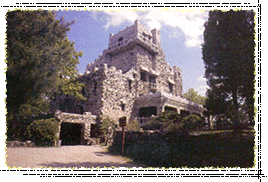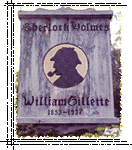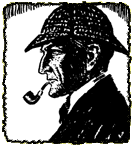 |
 |
 |
|
|||
|
Gillette Castle
It's hard to think of Sherlock Holmes and not picture Basil Rathbone. Yet the dashing Hollywood movie star actually owed much of his success as Holmes to a dyed-in-the-wool New Englander from Hartford, Connecticut. It was William Gillette, one of the most popular American actors of the early twentieth century, who pioneered the role of Sherlock Holmes on the stage. Something of man of mystery himself, Gillette built a magnificent castle-like mansion in a secluded grove overlooking the Connecticut River in Hadlyme, Connecticut, where he spent his final years.
William Gillette never actually referred to his home as a castle, even though he modeled it after the medieval ruins of a German fortress on the Rhine. With its sturdy towers and turrets, perched high above the Connecticut River, an hour south of Hartford, the place certainly looks like a castle from the outside, while inside . . . which you can tour for just a few dollars . . . has more of a hunting lodge feel to it. Tour Guide: "Now throughout the home, you're going to notice a lot of stone and wood. The stone is just fieldstone that was gathered from the local river valley, and Gillette paid farmers a dollar a cartload to bring it up to the castle for construction .
By far, his most famous role was that of Sherlock Holmes, played on the screen a generation later by Basil Rathbone. Gillette, however, pioneered the role in a play he wrote based on the stories of Arthur Conan Doyle. While Doyle may have created the character of Holmes, it was Gillette, not Rathbone, who added the finishing touches. Gillette Castle guide, Michael Trotochaud. Tour Guide: When Doyle wrote the stories, he gave us a brief physical description, not much about what he wore, and that was about it. When Gillette took on the role, he created what we know today. He brought in the deerstalker cap, the Inverness cape, he actually wrote the line, "Elementary, my dear Watson." You won't find that in any of the Doyle books.
An amateur architect/engineer, Gillette personally supervised much of the construction, such as the installation of a fountain in the conservatory, where his pet frogs, Mike and Lena, lived the good life. Gillette designed elaborate, hand carved latches for all 47 of the castle's massive doors, no two of which are alike. He also had a little fun with the bar, a four foot high wooden box, with a lid that flips open, if you know the combination, according to guide, Paula Antaya.
Gillette: People didn't tell me that I was born with a silver spoon in my mouth, but I've often heard that I was born with a steam engine in my mouth. And at last, I've got one. And, I'd like to see if some of you would like to take a ride along maybe, we'll have a little ride around the place, what do you say? All right, all right, we'll do it. Good thing. Yes. All right. Today, the trains are no longer in service, but there are carriage rides available throughout the park, where you can still see the old railroad's wooden trestles, bridges, and depots, one of which now serves as the gift shop. Another nice way to explore the park is along the 10 miles of original footpaths which wind their way through stately groves of hemlock, white oak, and red maple. Gillette left no heirs when died in 1937 at the age of 83, but he did make clear in his will that he'd rather see his home sold at a loss than end up in the hands of "some blithering saphead" who had no appreciation for the place. The state of Connecticut ended up buying the property in 1943 and has maintained it as a public park ever since. Whether or not state officials are just the sort of sapheads Gillette was referring to is, of course, debatable. While the castle and its grounds have suffered from some neglect over the years, the state did recently slate $3 million dollars towards a major restoration, an encore which Gillette himself would probably applaud. More Information: Looking for more detail? Way more? Check out the following site to leave no burning question unanswered. http://www.wuzzup.com/lowctriver/gillette/index.html Gillette Castle State Park Special Note: If you're planning a trip to Gillette Castle, you'd better get there before the end of the summer. Renovations begin the week after Labor Day and the castle will be closed for 18 months during construction. The park, however, with its trails, picnic grounds, and fine views of the castle will remain open, free of charge, as always.
|
 | American Public Media Home | Search | How to Listen ©2004 American Public Media | Terms of Use | Privacy Policy |

 Though few members of the public know Gillette today as Sherlock Holmes,
thousands flock to Hadlyme every year to visit Gillette Castle and its
grounds which are now a state park. The Savvy Traveler's Tom Verde traveled
upriver, into the heart of Yankee territory, and has this story.
Though few members of the public know Gillette today as Sherlock Holmes,
thousands flock to Hadlyme every year to visit Gillette Castle and its
grounds which are now a state park. The Savvy Traveler's Tom Verde traveled
upriver, into the heart of Yankee territory, and has this story.
 If local farmers thought Gillette was a little, well, let's say, eccentric,
they weren't alone. Gillette's parents . . . both prominent Hartford
citizens . . . told their son if he wanted to be, of all things, an actor,
he'd have to make it on his own. Which is precisely what he did. At the
height of his career, around the turn-of-the-century, Gillette co-starred
with leading ladies like Ethel Barrymore and raked-in as much as 300 grand
a year.
If local farmers thought Gillette was a little, well, let's say, eccentric,
they weren't alone. Gillette's parents . . . both prominent Hartford
citizens . . . told their son if he wanted to be, of all things, an actor,
he'd have to make it on his own. Which is precisely what he did. At the
height of his career, around the turn-of-the-century, Gillette co-starred
with leading ladies like Ethel Barrymore and raked-in as much as 300 grand
a year.
 By 1914, Gillette, childless and a widower, was ready to go into
semi-retirement. He purchased 120 acres of land in rural Hadlyme and over
the next decade dumped a million dollars into building his castle and its
grounds.
By 1914, Gillette, childless and a widower, was ready to go into
semi-retirement. He purchased 120 acres of land in rural Hadlyme and over
the next decade dumped a million dollars into building his castle and its
grounds.
 But Gillette delighted most in giving people rides on his trains, a pair of
narrow-gague engines that ran on three miles of track throughout the
property. Among Gillette's most prominent passengers were President Calvin
Coolidge and Mr. and Mrs. Albert Einstein. He also invited the public at
large to climb aboard, in the one and only talkie he ever made . . . a
newsreel from the late twenties, featuring Gillette at the throttle of one
of his beloved engines.
But Gillette delighted most in giving people rides on his trains, a pair of
narrow-gague engines that ran on three miles of track throughout the
property. Among Gillette's most prominent passengers were President Calvin
Coolidge and Mr. and Mrs. Albert Einstein. He also invited the public at
large to climb aboard, in the one and only talkie he ever made . . . a
newsreel from the late twenties, featuring Gillette at the throttle of one
of his beloved engines.